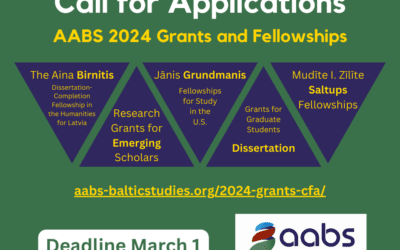AABS is pleased to recognize Sami Siva for his completion of the project “Baltic Borders,” for which he received the Baumanis Grant for Creative Projects in Baltic Studies.
“Baltic Borders” documents the stories of people living along the border regions of Estonia and Latvia through photographs. Its aim is to highlight the socio-political nuances of the region by sharing stories of ordinary people and their everyday lives. Please visit https://balticborders.ee/ for the full collection of stories and photographs.

©Sami Siva, 2022
Sami Siva is a Canadian photojournalist whose work is by and large focused on fractured identities. Previously, he has worked on documenting struggling identities within India, the aftermath of the Sri Lankan civil war, and various reportage in Central and Eastern Europe. He has also worked in the front lines in Eastern Ukraine. Sami is a recipient of three grants from Pulitzer Center on Crisis Reporting and multiple awards. His work has appeared in a number of international publications including The New York Times, The Globe and Mail, Foreign Policy Magazine, Al Jazeera, and The Guardian, among others. A portfolio of Sami’s work can be seen at www.samisiva.com. He holds a masters degree in Political Science, specializing in European Union–Russia Studies, from the University of Tartu.
The Impact of an Award: Report from Sami Siva
After the completion of “Baltic Borders,” Sami Siva submitted a reflection to AABS.
We thank him for his permission to publish his thoughts, which have been lightly edited.
The Baltic Borders project documents the stories of people living along the border regions of Estonia and Latvia through photographs. The focus of the project is to highlight the socio-political nuances of the region by sharing stories of ordinary people and their everyday lives.
The border regions of Estonia and Latvia have been part of political discussions stemming from their language differences since the fall of the Soviet Union in 1991. Efforts to integrate the ethnic Russians and the Russian speakers (people who migrated from different parts of the USSR) have been faced with various challenges in these countries. Since the annexation of Crimea in 2014, and in the wake of current war in Ukraine incited by Russia in February 2022, these border regions are inundated by misinformation disseminated through Russian TV channels; friends, families, and neighbors are divided in their political opinions. This photography project attempts to shed some light on the every day reality on the ground in these places.
The Baumanis Grant was immensely instrumental in conducting fieldwork and in documenting the lives of ordinary people in the border regions of Estonia and Latvia. This grant also allowed me—an outsider with a completely different cultural and language background—to visually explore the region. The fieldwork conducted for this creative project also contributed towards my MA (Political Science) thesis on communities living along the borders of Estonia. In the thesis, I explored the spatial and temporal aspects of these communities and how they contribute to the security narratives in Estonia. In addition, this grant allowed me to pursue using visual ethnographic studies as a methodological framework to conduct research in Political Science studies.
Photographs for this project come from Ida-Virumaa (specifically around Narva), the Peipsi region, and Setomaa in Estonia; all these regions border Russia and the Russian language is spoken. In Latvia, the work focuses on the Latgale, a region where Russian is spoken widely and shares borders with Belarus and Russia. Each of these regions is unique in its cultural and social construction tracing back to different times in history.
Narva, the third largest city in Estonia and the most populous city in the Ida-Virumaa region, was destroyed during the Second World War and repopulated by workers from different parts of the Soviet Union. Most of the people have lived their lives in the Russian-speaking environment since the 1940s. In this ‘gray zone,’ as one of the locals put it, many consume Russian TV programs, which makes Narva vulnerable to the Kremlin’s propaganda and subsequently results in a national security concern.
Old Believers are a community who escaped the Russian Empire prosecution in the 17th century and settled in the villages along the western shore of Lake Peipsi. Though the community practices their religious traditions and speak Russian, they are well integrated into Estonian culture.
The Setos, a Finno-Ugric community with unique traditions and cultural roots, live in the Southeastern part of the country. Their population is divided between Estonia and the Pechory region in Russia. Easier border crossing practices during the Soviet times and after 1991, when Estonia regained its independence, have allowed the Setos to continue their religious practices (e.g. visiting elders’ graves and churches) and maintain family ties. The Covid-19 pandemic and the current war in Ukraine have disrupted movements of Seto community members across the border.
In Latvia, the Latgale region has a deep-rooted historical past, including rich cultural roots tracing back to the Polish-Lithuanian Commonwealth and Russian Empire. Its varied history in the Post Second World War era drives the current constitution of the region, a multicultural and multilingual (Latvian, Latgalian and Russian) mélange. The history of the region is visibly represented in the local architecture, community practices, and construction of the society.
In both Estonia and Latvia, many of the locals in the border regions, especially in Narva and Latgale, mistrust their respective national governments in Tallinn and Riga. This mistrust among the population is mainly rooted in the issues revolving around the Russian speaking community in these regions. In addition, the lack of employment and limited opportunities to get higher education discourage local youth from staying in these regions.
Using a ‘snowball sampling’ approach, in which interlocutors often lead to meeting another, participants for this were chosen from a pool of people who were willing to take part and share their views. Semi-structured interviews were conducted to obtain nuanced perspectives from the participants.
Photographs and stories from this project are published on www.balticborders.com. Currently, the website has 32 stories of individuals and the places I visited. The website also has been set up in such a way that additional pages for essays and videos can be included in future. The ultimate goal is to extend this project to study the border regions in Lithuania and to organize exhibitions in various locations.

A screenshot of the front page of the Baltic Borders site. ©Sami Siva, Baltic Borders
What is the Baumanis Grant?
The Baumanis Grant is an award made to honor Velta Marija Baumanis of Mount Brydges, Ontario, who left a generous bequest to AABS at the end of her career as an architect. An award of up to $7,000 is available for any creative project (e.g., book, film, exhibit, etc.) that promotes Baltic studies. Preference is given to topics with a pan-Baltic or comparative aspect. Applicants must be members of the AABS at the time of application.
Applications for the past cycle were evaluated by the AABS 2021-2022 Grants and Awards Committee consisting of AABS VP for Professional Development Dr. Ineta Dabašinskienė, AABS President Dr. Daunis Auers, AABS Director-at-Large Dr. Andres Kasekamp, and AABS Treasurer Ugis Sprūdžs, CFA.
Other Grants and Fellowships News
Vanished Lands: Book Publication Subvention Report by Laima Vincė Sruoginis
The Association for the Advancement of Baltic Studies (AABS) is pleased to recognized the successful conclusion of a Book Publication Subvention Grant awarded to Peter Lang Publishers for publishing the book Vanished Lands: Memory and Postmemory in North American...
Elīna Vikmane Birnitis Fellowship Report on Advancing Cybermuseology
AABS is pleased to recognize Elīna Vikmane for the completion of her dissertation "Advancing Cybermuseology: Diffusion of digital innovation in Latvia’s museum sector," for which she received the 2022–2023 Aina Birnitis Dissertation-Completion Fellowship in the...
AABS 2024 Grant and Fellowship Applications Open
Call for Applications AABS 2024-2025 Grants and Fellowships Research Grants for Emerging Scholars The Aina Birnitis Dissertation-Completion Fellowship in the Humanities for Latvia Mudīte I. Zīlīte Saltups Fellowships Jānis Grundmanis Fellowships for...



